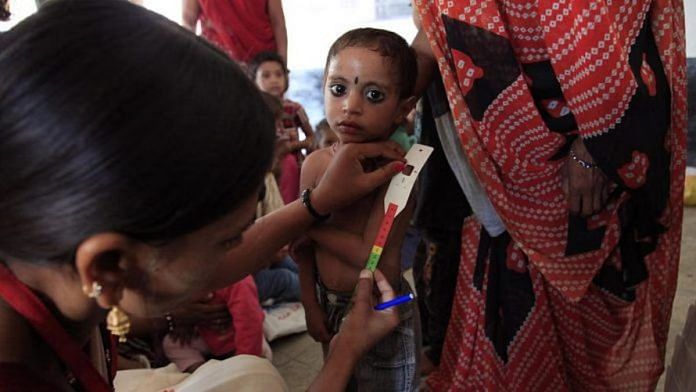Gurugram: Haryana grapples with significant health challenges for children and women, according to PRS Legislative Research’s analysis of the Ministry of Women and Child Development’s Demand for Grants for 2025-26.
The report says 28 percent of children under five years of age in Haryana are stunted (low height for age), 12 percent are wasted (low weight for height), and 40 percent are underweight (low weight for age). Additionally, 61 percent of breastfeeding women in the state are anaemic, with the prevalence of anaemia among children aged 6-59 months at 72 percent, one of the highest in India.
Given Haryana’s high per capita income (over Rs 3.25 lakh in 2024), robust agricultural production, and cultural emphasis on nutritious ‘doodh dahi ka khana’, the state paradoxically exhibits very poor indicators on women and child health, the report shows.
The analysis notes that the Ministry of Women and Child Development has been allocated Rs 26,890 crore for 2025-26, a 16 percent increase from the revised estimates of 2024-25.
In Haryana, funds released under Mission Poshan 2.0, which is aimed at addressing malnutrition, rose to Rs 226 crore in 2023-24 from Rs 185 crore in 2020-21.
However, utilisation challenges persist, with the report indicating that actual expenditure by the ministry has consistently been lower than budgeted allocations over the past nine years.
The Saksham Anganwadi and Poshan 2.0 scheme—aimed at improving nutrition for children, adolescent girls, pregnant women and lactating mothers—accounts for 82 percent of the ministry’s budget at Rs 21,960 crore.
In Haryana, Anganwadi Centres (AWCs) face infrastructural deficiencies, with 28 percent lacking functional toilets and 11 percent without drinking water facilities as of January 2025, says the report.
The report also notes that 6 percent of anganwadi worker posts and 8 percent helper posts are vacant.
In child undernutrition, Haryana’s underweight prevalence (40 percent) is significantly higher than that of Punjab (17 percent), Himachal Pradesh (21 percent), and Uttar Pradesh (32 percent). Haryana reports lower stunting (28 percent) than Uttar Pradesh (40 percent), but higher than Punjab (25 percent) and Himachal Pradesh (27 percent).
For anaemia, Haryana’s prevalence among children (6-59 months) is 71 percent, against Uttar Pradesh (66 percent), Punjab (66 percent) and Himachal Pradesh (58 percent).
Professor Rajeshwari from the Department of Geography, Kurukshetra University, told The Print that childhood undernutrition contributes to diseases and is a major cause of child mortality in India.
“It is disquieting to note that child nutrition statistics are not showing greater signs of improvement in Haryana. Even during the first six months of life, when almost all babies are breastfed, 18 percent of children are stunted, 25 percent are wasted, and 20 percent are underweight. Though there has been some improvement for under-5 children in wasting and stunting, underweight figures remain a cause of concern,” she added.
Professor Rajeshwari, who goes by her first name, further said that surprisingly, mothers’ nutrition is also not improving in Haryana, with more than 60 percent of married women suffering from anaemia, which results in low-birth-weight babies.
“Anaemia, a major health problem in Haryana, especially among women and children, can lead to maternal mortality, weakness, diminished physical and mental capacity, increased morbidity from infectious diseases, perinatal mortality, premature delivery, low birth weight, and impaired cognitive performance, motor development, and scholastic achievement in children,” she said.
The professor added that the overall prevalence of anaemia in children slightly decreased from 72 percent in National Family Health Survey or NFHS-4 to 70 percent in NFHS-5, with a slightly higher prevalence among boys (71 percent) than girls (70 percent).
Children born to educated and healthier mothers tend to be less malnourished, she said, and the condition becomes less prevalent lower in the birth order. Meanwhile, the level of undernutrition is relatively higher for rural children, children higher in the birth order, and Scheduled Caste children compared to other groups, and it tends to be lower among Sikh children, said Rajeshwari.
“Malnutrition is somewhat lower for female children than male children on all three nutritional status measures. Further, despite the Beti Bachao campaign, a strong son preference persists in Haryanvi society, with 10% of women and 11% of men wanting more sons than daughters, and 75% of men and 86% of women desiring at least one son. This preference for smaller families continues to impact women’s reproductive health and nutrition negatively, contributing to the loss of unborn girl children,” Rajeshwari added.
The budget analysis also highlights low female labour force participation in Haryana, with only 42 percent of women aged 15 and above engaged in work or seeking employment in 2023-24, compared to 79 percent for men.
(Edited by Gitanjali Das)
Also Read: 40,000 scholarships pending: Haryana SC/ST & OBCs panel flags gross lapses in welfare & fund use






